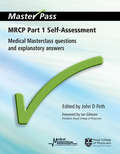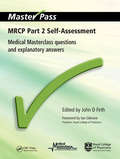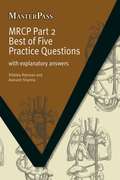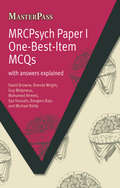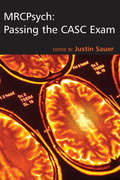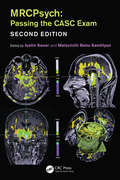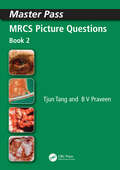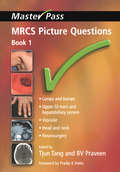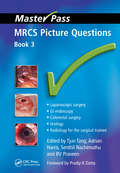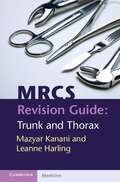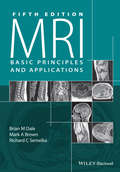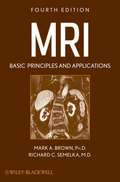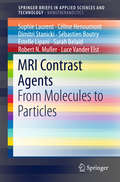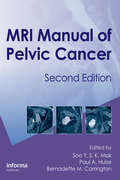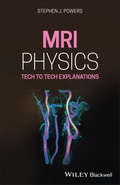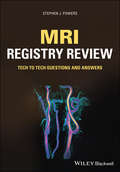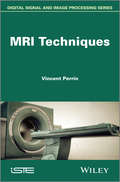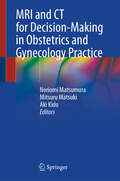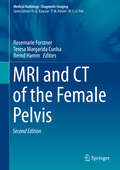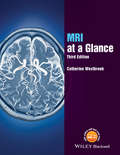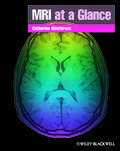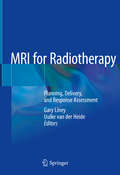- Table View
- List View
MRCP Part 1 Self-Assessment: Medical Masterclass Questions and Explanatory Answers (MasterPass)
by Mark Newman John D Firth"MRCP Part 1 Self-Assessment" is the perfect revision aid. Drawn from the highly successful Medical Masterclass material from the Royal College of Physicians of London, this concise volume is specifically designed to cover the topics and format found in the Membership to the Royal College of Physicians (MRCP) Part 1 examination. The large scale, lavishly illustrated, full-colour format makes it easy to comprehend complex topics. With contributions from an extensive list of prestigious and authoritative professionals, the questions cover all areas of assessment, including the scientific background the medicine, general clinical skills, acute medicine and a range of specialties. It is ideal for examination MRCP candidates, doctors preparing for the European Diploma in internal medicine and junior doctors wanting to revise their knowledge and skills.'This collection of self-assessment questions and explanatory answers has been drawn from Medical Masterclass, which is produced and published by the Royal College of Physicians of London. The questions have been specifically written to help doctors in their first few years of training to test and revise their medical knowledge and skills; and in particular to pass postgraduate examinations, such as the MRCP(UK)' - John D Firth, in the Introduction.
MRCP Part 2 Examination: A Candidate's Revision Notes (MasterPass)
by Ashley BondFinding the time to revise effectively is one of the greatest challenges that modern MRCP candidates face. This unique book by a recent successful candidate provides precisely what many have needed but been unable to find until now: the distilled essential knowledge required to pass the MRCP Part 2 exam. This book provides candidates with a concise and well-directed approach to fast and efficient revision, supplying comprehensive coverage of the MRCP syllabus and the key points of each topic. It stands apart from other MRCP revision resources in supplying both concise text and the essential lists needed to pass the Part 2 exam.
MRCP Part 2 Self-Assessment: Medical Masterclass Questions and Explanatory Answers (MasterPass)
by John D Firth Barbara Nichols"MRCP Part 2 Self-Assessment" is the perfect revision aid. Drawn from the highly successful Medical Masterclass material from the Royal College of Physicians of London, this concise volume is specifically designed to cover the topics and format found in the Membership to the Royal College of Physicians (MRCP) Part 1 examination. The large scale, lavishly illustrated, full-colour format makes it easy to comprehend complex topics.With contributions from an extensive list of prestigious and authoritative professionals, the questions cover all areas of assessment, including the scientific background the medicine, general clinical skills, acute medicine and a range of specialties. It is ideal for examination MRCP candidates, doctors preparing for the European Diploma in internal medicine and junior doctors wanting to revise their knowledge and skills.'This collection of self-assessment questions and explanatory answers has been drawn from Medical Masterclass, which is produced and published by the Royal College of Physicians of London. The questions have been specifically written to help doctors in their first few years of training to test and revise their medical knowledge and skills; and in particular to pass postgraduate examinations, such as the MRCP(UK)' - John D Firth, in the Introduction.
MRCP: With Explanatory Answers (MasterPass)
by Shibley Rahman Avinash SharmaThis book provides a bank of multiple-choice questions for candidates preparing for Part 2 of the Membership examination of the Royal Colleges of Physicians, the MRCP. The questions are arranged by subject area to enable structured revision and allow candidates to focus on particular areas where they feel less confident. The book has been written with a close focus on recent examinations, with the coverage of topics weighted to reflect the frequency with which they have appeared. The book is structured more as a manual than as a mock exam, and includes explanations for both correct and incorrect answers, focusing comprehensively on the fundamental principles of medical practice. As well as candiates for the MRCP, this book will also be of interest to medical students and students of related health sciences.
MRCPsych Paper I One-Best-Item MCQs: With Answers Explained (MasterPass)
by David Browne Brenda Wright Yvonne G. BakerThe past decade has seen several revisions to the MRCPsych examinations but the latest changes have been the most radical. It is now a three part written examination along with a clinical assessment of skills and competencies. This has changed the focus of the 'new' MRCPsych Paper I, which now includes two thirds 'one-best-item-from-five' multiple choice questions (MCQs). This collection of 'one-best-item-from-five' style multiple choice questions mirrors the new format for the exam. Its companion volume Extended Matching Items for the MRCPsych Examinations Part 1 by Michael Reilly and Bangaru Raju remains relevant for the new format where EMIs make up one third of the questions. Together, these two guides thoroughly prepare you for the revised format, incorporating the new areas of study such as basic ethics, philosophy and history of psychiatry, and stigma and culture. With varying degrees of question difficulty, a wide-range of styles and topics, and full explanations of answers overleaf, MRCPsych Paper I One-Best-Item MCQs is ideal for examination preparation and self-study.
MRCPsych: Passing the CASC Exam
by Justin SauerA newly-prepared revision guide tailored to the brand new Clinical Assessment of Skills and Competencies (CASC) portion of the MRCPsych exam, containing over 100 clinical scenarios and accompanied by the ideal 'answers' examiners will be looking for.
MRCPsych: Passing the CASC Exam, Second Edition
by Justin Sauer Malarvizhi B. SandilyanThis is a fully-updated, comprehensive guide for trainees preparing for the MRCPsych CASC exam (Clinical Assessment of Skills and Competencies). Success in the CASC is the final step in being awarded the MRCPsych qualification, which signifies the physician has fulfilled the necessary training requirements and has passed the membership exams conducted by the Royal College of Psychiatrists. The book is presented in a clear layout and covers the full range of psychiatry subspecialties likely to be encountered on exam day.
MRCS Picture Questions: A Practical Guide, v. 3 (MasterPass)
by Tjun Tang BV Praveen'It gives me immense personal pleasure to see this publication come to fruition - edited by two very committed young teachers, ably supported by several up and coming young surgeons who are setting out on the road to a surgical vocation. 'A picture is equal to a thousand words' - this adage is exemplified by the excellent pictures in this volume generously contributed by many young surgeons. The reader will find the following pages a compelling read. This book is the outcome of the painstaking collection of clinical material over many years by the two editors, aided by colleagues who have contributed much towards this very worthwhile publication.' Pradip K. Datta, in the Foreword from "Book 1".
MRCS Picture Questions: Bk. 1 (MasterPass)
by Tjun Tang B V PraveenThis book is an in-depth and practical guide to the problems alcohol can cause and the professional interventions that can help. It covers the impact of alcohol on various types of individuals and in various circumstances. It explores a variety of perspectives as well as physical spiritual social and legal issues. The book outlines the range of problems shows how they can be identified and examines appropriate approaches from different professional groups. A group of renowned international contributors has written Alcohol Use in a clear style to ensure the book is accessible and easy to use. It makes full use of case studies charts and self-assessment tools and a to learn more section points the reader to advanced forms of study. It is an essential resource for professionals working in this area and those considering entering it. 'The need to disseminate findings and the challenge to provide clear and relevant resources has been successfully met by this book. It allows the impact of alcohol use at various points along the life span as well as a variety of treatment and therapeutic options. In addition multiple learning devices such as interactive exercises self-assessment tools and case studies enhance the engagement of the reader. The author's provide the reader with a variety of national perspetives address such diverse and important areas as transcultural workplace and community issues. Healthcare professionals everywhere should feel encouraged by this book and the promise it offers for informed and effective care.' Olga Maranjian Church in the Foreword
MRCS Picture Questions: Bk. 3 (MasterPass)
by Tjun Tang Bandipalyam Vamana Rao PraveenThis superb, full-colour, visual revision aid has been designed specifically to candidates of the Member of the Royal College of Surgeons (MRCS) examination. It is also an invaluable diagnostic aid for all medical students and trainees, especially those on surgical rotations. Questions are based on a single clinical picture with comprehensive answers overleaf. Topics covered by this volume include laparoscopic surgery, upper and lower GI endoscopy, colorectal surgery and urology.
MRCS Revision Guide: Trunk and Thorax
by Leanne Harling Mazyar KananiThe new MRCS structure replaces the vivas and clinical style examinations with an OSCE-based system. This revision guide - the first in a series - fully reflects this new format and provides a structured, systems-based approach to revision. Key aspects of anatomy, physiology, critical care, surgical pathology and operative care are combined whilst focusing on the questions commonly asked in the exam. The material is presented in a practical, question-and-answer based format to help readers retain details whilst providing all of the essential information needed for examination success. MRCS Revision Guide: Trunk and Thorax is a concise, clear pocketbook that reduces the need for bulky textbooks by providing a quick reference guide for busy surgical trainees. If you are studying for the MRCS examination, you need this book.
MRI
by Mark A. Brown Richard C. Semelka Brian M. DaleThis fifth edition of the most accessible introduction to MRI principles and applications from renowned teachers in the field provides an understandable yet comprehensive update. Accessible introductory guide from renowned teachers in the field Provides a concise yet thorough introduction for MRI focusing on fundamental physics, pulse sequences, and clinical applications without presenting advanced math Takes a practical approach, including up-to-date protocols, and supports technical concepts with thorough explanations and illustrations Highlights sections that are directly relevant to radiology board exams Presents new information on the latest scan techniques and applications including 3 Tesla whole body scanners, safety issues, and the nephrotoxic effects of gadolinium-based contrast media
MRI
by Mark A. Brown Richard C. SemelkaFourth Edition Brings This Popular Guide Thoroughly Up To Date With The Latest MRI Findings, Techniques, And ApplicationsFor its Fourth Edition, the acclaimed MRI: Basic Principles and Applications has been rigorously revised, enabling readers to quickly master the principles and take advantage of all the latest MRI applications. Among the new materials are fresh and updated discussions on 3D imaging, real-time imaging, cardiac imaging, and parallel acquisition techniques. In addition, readers will find dozens of brand-new images to illustrate key concepts. Moreover, clinical protocols have been thoroughly updated and revised to reflect current methodologies.Throughout the book, readers will find easy-to-follow coverage of all the latest findings, technologies, and techniques, including:Nephrotoxic effects of gadolinium-based contrast mediaNew scan techniques, including radial scanningParallel acquisition and cardiovascular imaging techniquesNew applications, including spin tagging and diffusion tensor imaging3 Tesla and 7 Tesla scanningHardware innovations, including large-scale array coilsNew motion compensation techniquesWith its clear explanations and ample illustrations, this Fourth Edition maintains all the hallmarks of the previous edition that have made this book a fixture in MRI labs around the world. Students and practitioners--from physicians to radiologists to technicians--will gain a full, accurate understanding of the underlying physics and the clinical applications of MRI, all with a minimum of mathematical formulas and technical details.From Reviews of the Third Edition". . . successful in transferring key ideas in an undaunting and progressive manner . . . thoroughly deserves a place on the bookshelf."--NMR in Biomedicine, Vol 17(4), June 2004". . . it will reward the reader with an understanding of the principles underpinning nuclear magnetic resonance."--Yale Journal of Biology and Medicine, May 2003
MRI Contrast Agents
by Sophie Laurent Céline Henoumont Dimitri Stanicki Sébastien Boutry Estelle Lipani Sarah Belaid Robert N. Muller Luce Vander ElstThis book describes the multiple aspects of (i) preparation of the magnetic core, (ii) the stabilization with different coatings, (iii) the physico-chemical characterization and (iv) the vectorization to obtain specific nanosystems. Several bio-applications are also presented in this book. In the early days of Magnetic Resonance Imaging (MRI), paramagnetic ions were proposed as contrast agents to enhance the diagnostic quality of MR images. Since then, academic and industrial efforts have been devoted to the development of new and more efficient molecular, supramolecular and nanoparticular systems. Old concepts and theories, like paramagnetic relaxation, were revisited and exploited, leading to new scientific tracks. With their high relaxivity payload, the superparamagnetic nanoparticles are very appealing in the context of molecular imaging but challenges are still numerous: absence of toxicity, specificity, ability to cross the biological barriers, etc.
MRI From Picture to Proton
by Donald W. Mcrobbie Elizabeth A. Moore Martin J. Graves Martin R. PrinceMRI from Picture to Proton presents the basics of MR practice and theory in a unique way: backwards! The subject is approached just as a new MR practitioner would encounter MRI: starting from the images, equipment and scanning protocols, rather than pages of physics theory. The reader is brought face-to-face with issues pertinent to practice immediately, filling in the theoretical background as their experience of scanning grows. Key ideas are introduced in an intuitive manner which is faithful to the underlying physics but avoids the need for difficult or distracting mathematics. Additional explanations for the more technically inquisitive are given in optional secondary text boxes. The new edition is fully up-dated to reflect the most recent advances, and includes a new chapter on parallel imaging. Informal in style and informed in content, written by recognized effective communicators of MR, this is an essential text for the student of MR.
MRI Handbook
by Muhammed Elmaoğlu Azim ÇelikMRI Handbook presents a concise review of the physical principles underlying magnetic resonance imaging (MRI), explaining MR physics, patient positioning, and protocols in an easy-to-read format. The first five chapters of the book introduce the reader to the basics of MR imaging, including the relaxation concept, MR pulse sequences, and MR imaging parameters and options. The second part of the book (chapters 6-11) uses extensive illustrations, images, and protocol tables to explain tips and tricks to achieve optimal MR image quality while ensuring patient safety. Individual chapters are devoted to each major anatomic region, including the central nervous, musculoskeletal, and cardiovascular systems. By using annotated MR images and examples of patient positions used during scanning correlated with sample protocols and parameters, MRI Handbook is a practical resource for imaging professionals to use in the course of their daily practice as well as for students to learn the basic concepts of MR imaging.
MRI Manual of Pelvic Cancer
by Soo Y. S. K. Mak Paul A. Hulse Bernadette M. CarringtonWritten by internationally renowned authors, this title is an invaluable reference for all those required to report on MR examinations, with accurate cancer staging aided by the extensive use of high quality MR images of pelvic cancer.Each chapter gives a short account of every disease and a set of images demonstrating the tumour, node and metastas
MRI Physics: Tech to Tech Explanations
by Stephen J. PowersTechnologists must have a solid understanding of the physics behind Magnetic Resonance Imaging (MRI), including safety, the hows and whys of the quantum physics of the MR phenomenon, and how to competently operate MRI scanners. Generating the highest quality images of the human body involves thorough knowledge of scanner hardware, pulse sequences, image contrast, geometric parameters, and tissue suppression techniques. MRI Physics: Tech to Tech Explanations is designed to help student MRI technologists and radiotherapists preparing for Advanced MRI certification examinations to better understand difficult concepts and topics in a quick and easy manner. Written by a highly experienced technologist, this useful guide provides clear and reader-friendly coverage of what every MR Technologist needs to know. Topics include safety considerations associated with the magnetic field and RF, pulse sequences, artifacts, MRI math, the much-feared gradients, and I.V. contrast. Provides basic guidance on safety considerations, protocols options, critical thinking, and image contrast optimization Simplifies the challenging topic of MRI physics using straightforward language and clear explanations Covers content for American Registry of Radiologic Technologists (ARRT) and Continuing Qualifications Requirements (CQR) exams Features numerous illustrations and photographs of various MRI concepts, pulse sequence design, artifacts, and the application of concepts in clinical settings MRI Physics: Tech to Tech Explanations is a must-have resource for the experienced and training MRI technologist, medical students, and radiology residency rotations.
MRI Registry Review: Tech to Tech Questions and Answers
by Stephen J. PowersMRI Registry Review: Tech to Tech Question and Answers is a comprehensive question and answer book designed to help scanning technologists pass their MRI Board certification examinations, particularly the ‘Registry’ and Continuing Qualifications Requirements (CQR) exams administered by the American Registry of Radiologic Technologists (ARRT). The book provides clear explanations and accurate answers to numerous multiple-choice questions (MCQs) similar to those found in ARRT exams, as well as study tips and additional information on many key topics. The questions are organized into four sections aligned with ARRT content specifications, covering patient care during an MRI, the physical principles of MRI, data acquisition, and imaging procedures. Written for MRI students and working technologists alike, the book is the perfect complement to MRI Physics: Tech to Tech Question and Answers—the author’s popular guide that explains difficult MRI concepts and topics with a clear and straightforward approach. Offering a wide variety of questions and succinct yet thorough explanations, this valuable study and review guide: Covers the topics technologists need to know in order to pass ARRT exams Offers exam preparation and test-taking suggestions and advice Groups questions together by topic to allow readers to focus on specific areas needing more attention Includes tables, figures, cross-vendor terminology lists, and illustrations that reinforce key points and demonstrate application to practice Links sections to corresponding chapters in the companion MRI Physics: Tech to Tech Explanations MRI Registry Review: Tech to Tech Question and Answers is an indispensable study tool for students and trainees preparing for the ARRT or equivalent advanced MRI placement exams, as well as for technologists needing to re-certify or take CQR exams.
MRI Techniques
by Vincent PerrinThe rapid developments in magnetic resonance imaging (MRI) over the past 20 years have affirmed its supremacy over most other means of non-invasive exploration of the human body. This progress has had other consequences for imaging physicists: having knowledge about only one of the sides of MRI is nowadays no longer enough to develop new sequences or even to learn more about those that already exist. It is necessary to have a clear and precise view of all the fields explored today by this imaging technique, such as rapid imaging, flows, diffusion, perfusion or even functional MRI.This book aims to allow readers with the basics of physics and mathematics within the field MRI to easily immerse themselves in techniques that are not familiar to them. Pragmatic in approach, moving between the physics underlying the techniques being studied and the clinical examination of images, it will also be of interest to radiologists looking to define protocols or make better use of the images obtained. Contents 1. Flow.2. Diffusion.3. Perfusion.4. Functional MRI. About the Authors Vincent Perrin is a specialist teacher in the fields of physics and chemistry.
MRI and CT for Decision-Making in Obstetrics and Gynecology Practice
by Noriomi Matsumura Mitsuru Matsuki Aki KidoThis practical book provides guides to the effective use of diagnostic imaging from MRI and CT scans, aiming to familiarize clinicians with the pathophysiology and how to interpret the imaging findings for making clinical decisions for obstetric and gynecological diseases. This book starts with a general introduction to explain the basics of MRI, CT, and PET/CT, written by experts in diagnostic imaging in a clear-cut style. The following parts describe the differential diagnosis of ovarian diseases, uterine tumors, and placenta and pregnancy-related diseases. Clinicians must understand the advantages, disadvantages, and limitations of MRI, CT, and PET-CT for patient-oriented medical care. It is also essential to have the most appropriate examination at the proper time and use the diagnostic imaging in critical phases to decide the course of medical treatment. MRI and CT for Decision-Making in Obstetrics and Gynecology Practice shares tips and insights into the practical interpretation of the diagnostic imaging for obstetricians, gynecologists, and diagnostic imaging physicians to help make critical decisions in day-to-day practice. The book inspires and offers insights to promote mutual understanding and collaboration between radiologists and clinical oncologists.
MRI and CT of the Female Pelvis (Medical Radiology)
by Bernd Hamm Rosemarie Forstner Teresa Margarida CunhaThis volume provides a comprehensive and up-to-date account of the use of MRI and CT to identify and characterize developmental anomalies and acquired diseases of the female genital tract. Both benign and malignant diseases are considered in depth, and detailed attention is also paid to normal anatomic findings and variants. Further individual chapters focus on the patient with pelvic pain and the use of MRI for pelvimetry during pregnancy and the evaluation of fertility. Compared with the first edition, chapters have been either newly written by different authors or updated to reflect intervening progress; in addition, imaging of the placenta is now covered. Throughout, emphasis is placed on the most recent diagnostic and technical advances, and the text is complemented by many detailed and informative illustrations. All of the authors are acknowledged experts in diagnostic imaging of the female pelvis, and the volume will prove an invaluable aid to everyone with an interest in this field.
MRI at a Glance (At a Glance)
by Catherine WestbrookMRI at a Glance provides concise, easily accessible information on MRI physics and is an invaluable revision aid. All topics are included from magnetism to safety, K space to pulse sequences, image contrast to artefacts. The second edition has been fully revised and updated with brand new information on data acquisition and pulse sequences. The book is now in full colour throughout and follows the familiar, easy-to-use at a Glance format with each topic presented as a double-page spread with key facts accompanied by clear diagrams encapsulating essential knowledge.
MRI at a Glance (At a Glance)
by Catherine WestbrookMRI at a Glance provides concise, easily accessible information on MRI physics and is an invaluable revision aid. All topics are included from magnetism to safety, K space to pulse sequences, image contrast to artefacts. The second edition has been fully revised and updated with brand new information on data acquisition and pulse sequences. The book is now in full colour throughout and follows the familiar, easy-to-use at a Glance format with each topic presented as a double-page spread with key facts accompanied by clear diagrams encapsulating essential knowledge.
MRI for Radiotherapy: Planning, Delivery, and Response Assessment
by Gary Liney Uulke van der HeideThis book provides, for the first time, a unified approach to the application of MRI in radiotherapy that incorporates both a physics and a clinical perspective. Readers will find detailed information and guidance on the role of MRI in all aspects of treatment, from dose planning, with or without CT, through to response assessment. Extensive coverage is devoted to the latest technological developments and emerging options. These include hybrid MRI treatment systems, such as MRI-Linac and proton-guided systems, which are ushering in an era of real-time MRI guidance. The past decade has witnessed an unprecedented rise in the use of MRI in the radiation treatment of cancer. The development of highly conformal dose delivery techniques has led to a growing need to harness advanced imaging for patient treatment. With its flexible soft tissue contrast and ability to acquire functional information, MRI offers advantages at all stages of treatment. In documenting the state of the art in the field, this book will be of value to a wide range of professionals. The authors are international experts drawn from the scientific committee of the 2017 MR in RT symposium and the faculty of the ESTRO teaching course on imaging for physicists.
